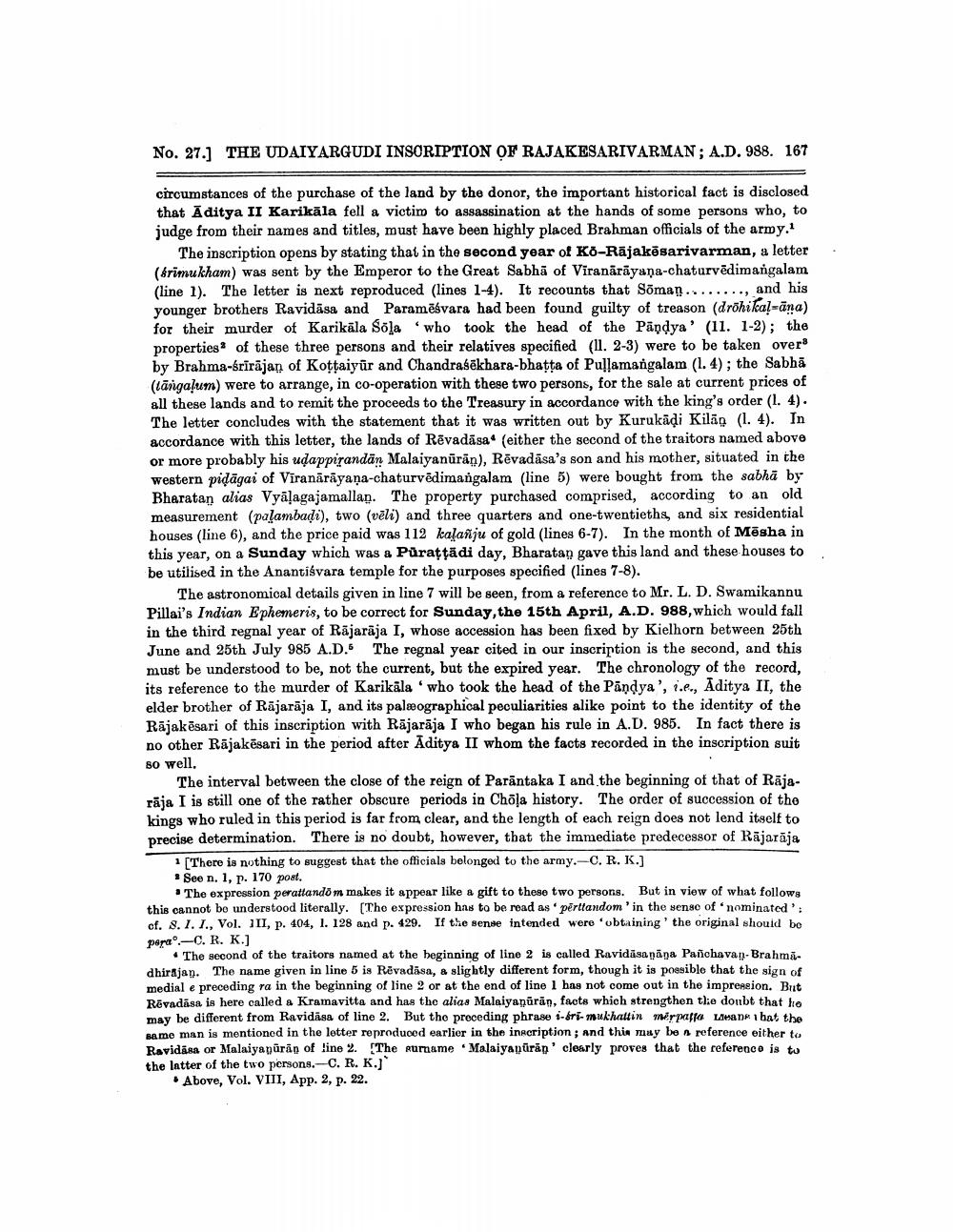________________
No. 27.] THE UDAIYARGUDI INSCRIPTION OF RAJAKESARIVARMAN; A.D. 988. 167
circumstances of the purchase of the land by the donor, the important historical fact is disclosed that Aditya II Karikāla fell a victim to assassination at the hands of some persons who, to judge from their names and titles, must have been highly placed Brahman officials of the army.
The inscription opens by stating that in the second year of Ko-Rājakēsarivarman, a letter (Srimukham) was sent by the Emperor to the Great Sabhā of Viranārāyana-chaturvēdimangalam (line 1). The letter is next reproduced (lines 1-4). It recounts that Sõman........, and his younger brothers Ravidāsa and Paramēśvara had been found guilty of treason (drõhikal-āna) for their murder of Karikäla Sola who took the head of the Pandya' (11. 1-2); the properties of these three persons and their relatives specified (11. 2-3) were to be taken over by Brahma-brirājan of Kottaiyür and Chandrasekhara-bhatta of Pullamangalam (1.4); the Sabha (tāngalum) were to arrange, in co-operation with these two persons, for the sale at current prices of all these lands and to remit the proceeds to the Treasury in accordance with the king's order (1. 4). The letter concludes with the statement that it was written out by Kurukādi Kilág (l. 4). In accordance with this letter, the lands of Rēvadāsa (either the second of the traitors named above or more probably his udappirandän Malaiyanūrāg), Rēvadāsa's son and his mother, situated in the western pidāgai of Viranārāyana-chaturvēdimangalam (line 5) were bought from the sabhā by Bharatan alias Vyālagajamallan. The property purchased comprised, according to an old measurement (palambadi), two (vēli) and three quarters and one-twentieths, and six residential houses (line 6), and the price paid was 112 kaļañju of gold (lines 6-7). In the month of Mēsha in this year, on a Sunday which was a Purațţādi day, Bharatan gave this land and these houses to be utilised in the Anantisvara temple for the purposes specified (lines 7-8).
The astronomical details given in line 7 will be seen, from a reference to Mr. L. D. Swamikannu Pillai's Indian Ephemeris, to be correct for Sunday, the 15th April, A.D. 988, which would fall in the third regnal year of Rājarāja I, whose accession has been fixed by Kielhorn between 25th June and 25th July 985 A.D. The regnal year cited in our inscription is the second, and this must be understood to be, not the current, but the expired year. The chronology of the record. its reference to the murder of Karikāla 'who took the head of the Pandya', i.e., Aditya II, the elder brother of Rājarāja I, and its palæographical peculiarities alike point to the identity of the Rajakesari of this inscription with Rājarāja I who began his rule in A.D. 985. In fact there is no other Rājakesari in the period after Aditya II whom the facts recorded in the inscription suit so well.
The interval between the close of the reign of Parāntaka I and the beginning of that of Rāja. rāja I is still one of the rather obscure periods in Chõļa history. The order of succession of the kings who ruled in this period is far from clear, and the length of each reign does not lend itself to precise determination. There is no doubt, however, that the immediate predecessor of Rajaraja
1 [There is nothing to suggest that the officials belonged to the army.-C. R. K.] * See n. 1, p. 170 poet.
• The expression perattandom makes it appear like a gift to these two persons. But in view of what follows this cannot be understood literally. (The expression has to be read as pērttandom' in the sense of nominated'. cf. 8.1.1., Vol. II, p. 404, l. 128 and p. 429. If the sense intended were obtaining the original should be pepa -C. R. K.)
The second of the traitors named at the beginning of line 2 is called Ravidāsaņāņa Panchavan-Brahmidhirajan. The name given in line 5 is Rēvadása, a slightly different form, though it is possible that the sign of medial e preceding ra in the beginning of line 2 or at the end of line 1 has not come out in the impression. But Rovadása is here called a Kramavitta and has the alias Malaiyanürån, facts which strengthen the doubt that ho may be different from Ravidasa of line 2. But the preceding phrase s-ari-mukhaltin mirpatio La De 1 bat the Anme man is mentioned in the letter reproducod earlier in the inscription, and this may be reference either to Ravidian or Malaiyapuran of line 2. The purame Malaiyanürånclourly proves that the referenco is to the Intter of the two persons.-C. R. K.)
Above, Vol. VIII, App. 2, p. 22.




